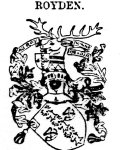
Mike Royden's
Royden Family History Pages
 |
Mike Royden'sRoyden Family History Pages |
 |
Bombardier Charles Royden D Battery, 18th Brigade R.F.A. (1881-1918)A Biography - by Mike RoydenWhen I first began reseaching the history of my family as a school project in the early 1970s, I could only get a far as my Great Grandfather, Charles Royden. He had died in the Great War many years earlier and all family memories of him seemed to have died with him. It took me several years to learn the methods of family research and to make an effective approach into Charles family and ancestry.Over the years I have researched his life and movements during the First World War, which have also included numerous visits to the battlefields of Belgium and France to discover more about his war experience and finally where he was killed in action. This now part of a larger work covering his sister and brothers who were also badly affected by the war. For the full version click here. Click picture, select 'save as' and save the file to your computer where you can then open it. Please be patient, this is a large file (12MB) and may take a few minutes to download. Once opened in Acrobat Reader it may be better to read it by going to the top menu and selecting: view / page display / two up |
If you cannot open the file it is likely you do not have Acrobt Reader installed on your computer. Download it from here (click image left).
|
|
 |
 |

|
War Medals and PlaqueBritish and Commonwealth servicemen and servicewomen were awarded a wide variety of orders, medals and decorations for their service in the First World War. These included medals for gallantry, distinguished service and those bestowed by Allied governments. General service during the First World War was recognised by the issue of the 1914 Star (or the 1914-15 Star), the British War Medal 1914-1920 and the Victory Medal 1914-1919. The usual trio of awards, the 1914 Star (or the 1914-15 Star if appropriate) together with the two service medals became popularly known as ‘Pip, Squeak and Wilfred’ after characters in a Daily Mail cartoon of the period. |
|
 |
The R.F.A. Cap Badge |

It was not until August 1917, in the midst of the Third Battle of Ypres, that the memorial 'plate' project resurfaced in the General Committee's decision that the commemoration should now take the form of bronze plaque. The announcement was reported in The Times for Monday 13 August 1917 and the public competition for appropriate designs described in extravagant detail.
The first prize of £250, for two model designs, was awarded to 'Pyramus' - Edward Carter Preston of the Sandon Studios Society, Liverpool
Production of the plaques began in December 1918 and around 1,150,000 were made. The plaques issued commemorated those men and women who died between 4 August 1914 and 10 January 1920 who had been killed on active service.
Memorial Scrolls were also sent to the next of kin and were sent out in seven and a quarter inch long cardboard tubes. The plaques themselves were dispatched under separate cover in stiff card wrapping enclosed within white envelopes bearing the Royal Arms. Both memorials were accompanied by a letter from King George V which bore his facsimile signature and read as follows:
I join with my grateful people in sending you this memorial of a brave life given for others in the Great War. George R.I.
 A detailed account of the Royal Canadian Artillery advance at Vimy Ridge and the memorial is given on their web site - click the flag.
A detailed account of the Royal Canadian Artillery advance at Vimy Ridge and the memorial is given on their web site - click the flag.
 |
Return to Home Page |
 |
Return to Royden Branches Page |